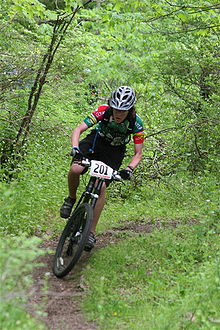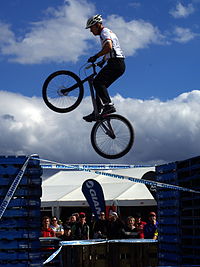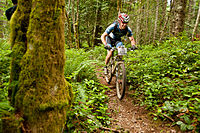- Mountain bike racing
-
 A rider during a Cross-country race
A rider during a Cross-country race
The Union Cycliste Internationale (UCI) recognised the sport of mountain bike racing relatively late in 1990, when it sanctioned the world championships in Purgatory, Colorado. The first mountain biking world cup series took place in 1991. Its nine-race circuit covered two continents—Europe and North America—and was sponsored by Grundig. In 1992, the Grundig-UCI world cup circuit expanded to ten races, and remained a trans-Atlantic series. Cross-country racing was the only world cup sport at this time, then in 1993 a six-event downhill world cup was introduced. In 1996, cross-country mountain biking events were added to the Olympic Games. NORBA refers to the Board of Trustees that represent the sport of mountain bike racing for USA Cycling. There are three USA Cycling Mountain Bike National Calendars: Endurance, Gravity and Ultra-Endurance. USA Cycling runs the USA Cycling Mountain Bike National Championships. In 2006, cross-country mountain biking events became part of the World Deaf Cycling Championships for the first time in San Francisco, USA.[1] There are mountain bike racing types that are not recognized by the UCI, such as mountain bike orienteering, that are governed by the IOF.
Contents
Types of mountain bike races
- Cross-country - Cross-country (XC) racing is held on a varied terrain circuit, it is normally around 6-8 kilometers (km) and is always a massed-start race. Under the controversial new 2006 UCI rules, elite, U23, and Junior Expert riders at UCI sanctioned races, are allowed technical assistance, but only in designated zones and only by an authorized team mechanic. However, riders in the same team can help each other at any point in the race. Under NORBA rules, no technical assistance is allowed. Professional level races are longer in distance, around 50 km.
- Short track Cross-country - Short Track Cross Country (XCC). A very short XC style event of about 800m in length but generally about 1 minute 30 seconds in winning time. A short, sharp exciting event to watch and participate in.
- Downhill - Downhill (DH) racing is a time trial event. Riders start at intervals that can vary from 30 seconds to three minutes-depending on the stage of the competition - and the rider with the lowest time wins. As the name of this discipline implies, DH races are held in steep, downhill terrain, resulting in higher speed than in cross-country racing. The terrain is also significantly rougher than in cross-country racing. The bike is designed with long travel suspension and hydraulic disc brakes.
- Super D - Super D (SD) is a blend of cross-country and downhill. Most of the race is downhill, on trails similar to the downhill segment of a cross-country race. There are also short (100–500m) uphill sections which make the use of downhill bicycles difficult, as a result, most riders use cross-country or 'trail bikes'. Depending on the trail and race venue, the start may either be seeded (riders start in short intervals), or Le Mans mass start (riders run to their bikes, timing is started when the riders start running). Probably the most famous of this type is the Megavalanche.
- Freeride - Freeride (FR) competitions are not so much a race as they are a competition of skill. Courses contain varying cliffs, drops, obstacles, and ramps. There are usually a large number of ways in which to complete the course, and scoring is dependent on the competitor's choice of routes, the fluidity of riding and tricks performed (style), and sometimes also the time in which the course is completed.
- Dual Slalom/Dual - Dual Slalom (DS) is a ski-inspired event which pits two riders against each other on two identical man-made tracks side-by-side with the same jumps and berms, with a rider on each track, and the first across the line wins. The contest has a knock-out format. Dual (DL) events are similar, only two riders share the same course/track. So dual is a contact sport.
- Four cross - (4X, also known as 'mountain cross' or 'bikercross') inspired by the dual format and by BMX racing, this event pits four riders on the same course from starting gates to finish. There can only be one winner per event, so the races can quickly eliminate riders making the progression faster for a day's events. This is the reason it was chosen as the race-format to replace Dual-Slalom by the UCI at World Cup events. 4X also replaced Dual in the UCI World Cup series in 2002. There is a difference between 4x and mountain cross. The difference is that in 4x, riders are each given a run down the course which is timed and the top 50% of the field then progress to the elimination rounds. In mountain cross, riders are given 3 heats against 3 other riders and points are allocated for your position in each heat. once again, the top 50% progress to the elimination rounds. 4x is the format raced in world cup however mtnx, is the preferred format for amateur races.
- Marathon - Marathon (XCM) is perhaps the toughest form of mountain biking because riders often have to cover more than 80 km in one race on mountaineous terrain. The distances usually vary from 60 km to 100 km. Races often exceed 100 km, but are then termed Ultra-Marathons. Recently UCI has inaugurated the Marathon World Cup. Basically it equals point-to-point (PP) discipline and that means that riders have a mass start from point "A" and they finish at point "B".
- Enduro - Enduro (ND) is a relatively new format which appears to have taken some inspiration from both car rally and motorbike enduro racing. Mountain bike enduro is essentially the competitive side of the mountain biking format often referred to today as "All-Mountain". It is a stage-race format where the winner is the rider who accumulates the lowest combined time from the various timed sections. Mountain bike enduro competitions typically take place over the course of 1 or 2 days, however, week-long enduro competitions do also exist. A typical one-day enduro race consists of 3 to 5 timed "special" stages which take place on technically demanding, generally descending terrain. These special stages are linked by predominantly ascending "liaison" stages. Although a rider's specific performance on the physically demanding liaison stages does not affect his or her result, the liaisons are often associated with a time-cut off (i.e. a latest permitted arrival at the summit of the next special stage). Due to this eclectic combination of attributes, enduro racing is increasingly recognised as the truest test of the all-round mountain biker. The sport has taken root in mostly in the Northwest of United States, a location known for its miles of winding single-track trails alongside old growth forest and bubbling creeks. Northwest Epic Series is the most famous series in Washington state that offers race distances ranging from 30 miles all the way to 100 miles.[2]
- Stage Races - Stage Races consist of several races - 'stages' - ridden consecutively, usually over a period of several days. A stage is usually similar in length and structure to a Marathon mountain bike race. The competitor with the lowest cumulative time to complete all the stages is declared the overall, or General Classification (GC), winner. Stage races may also have other classifications and awards, such as individual stage winners.
- Bike trials - Slow negotiation of man-made and natural obstacles where setting a foot down constitutes a penalty.
- Dirt jumping - Dirt jumping (DJ), similar to freeride, it is a competition of skill, differing that it involves the rider to jump off mounds of dirt to perform the best tricks with the best style. It differs to freeriding that the jumps are usually much larger and designed to lift the rider higher into the air and the bicycle is different to its counterpart.
- Mountain bike orienteering (MTB-O or MTBO) is an orienteering sport on a mountain bike where navigation is done along trails and tracks. The major focus becomes route choice while navigating at bike speed. Special equipment used is a map holder attached to the handlebar of the bike. The sport is governed by International Orienteering Federation.
Mountain bike events by country
- Australia
- Canada
- Canal Days Mountain Bike Race[5] in Port Colborne, Ontario
- Paris to Ancaster[6] in Ontario, Canada
- Lake to Lake[7] in Ontario, Canada
- Off-Road Squeezer[8] in Ontario, Canada
- 24 Hours of Adrenalin
- Crank The Shield in Haliburton, Ontario
- Crankworx, a week-long event in Whistler, British Columbia
- Transrockies, a 7 day stage race in British Columbia
- BC Bike Race, a 7 day stage race,the Ultimate Singletrack Experience in British Columbia
- India
- Ireland
- Mexico
- Chupacabras, a race in Juárez
- Mongolia
- Central Mongolia Mountainbike Challenge CMMC 2010[11]
- New Zealand
- 125 km race around Lake Hawea, Central Otago[12]
- Poland
- South Africa
- USA
- The Iceman Cometh Challenge (Michigan)[18]
- Northwest Epic Series Mountain Bike Race (Washington State)[19]
- Southeast Mountain Bike Racing[20]
- Attack on Swayback (Wetumpka, Alabama[21]
- Capitol Forest 100 Mile Mountain Bike Race (Olympia, Washington)[22]
- Bump N' Grind (Oak Mountain State Park, Pelham, Alabama)[23]
- Championship Series[24]
- Utah State Downhill Mountain Bike Series[25]
- Minnesota State Championship Series[26]
- Wisconsin Off-Road Series[27]
- Mountain Bike Skills Camps[28]
- Mountain States Cup Mountain Bike Series[29]
- Oklahoma Tour de Dirt[30]
- Sea Otter Classic
- Chequamegon Fat Tire Festival[31]
- UK
See also
- Bicycle Motocross
- Bunny hop (cycling)
- Cyclo-cross
- Mountain bike
- Mountain biking
References
- ^ "2006 World Deaf Championships Schedule". http://www.usdeafsports.org/2006cycling/news_announcement.html. Retrieved 19 March 2011.
- ^ "Northwest Epic Series", Northwest Epic Series, http://www.nwepicseries.com/, retrieved 2011-03-12
- ^ Fullgaspromotions.com.au
- ^ [1]
- ^ Fullgasspromotions.com.au
- ^ Parisancaster.com
- ^ Laketolake.ca
- ^ Squeezer.com
- ^ Irishdh.com
- ^ Irishxcmtb.com
- ^ Mountainbikemongolia.com
- ^ Lakehaweaepic.co.nz
- ^ Grandprixmtb.infocity.pl
- ^ MTB.webworld.pl
- ^ MTBtrophy.webworld.pl
- ^ Cratercruise.co.za
- ^ Cyclechallenge.co.za
- ^ Iceman.com
- ^ NWepicseries.com
- ^ Southernadventuresports.com
- ^ Attackonswayback.com
- ^ Capitolforest100.com
- ^ Bumpngrindrace.com
- ^ Arkansas Mountainbike AMBCS.com
- ^ Go-ride.com
- ^ MNSCS.com
- ^ WORS.org
- ^ Betterride.net
- ^ Racemsc.com
- ^ Okearthbike.com
- ^ Cheqfattire.com
- ^ Provelosupportuk.co.uk
- ^ Nps4x.com
- ^ Twentyfour12.com
- ^ Thefordmtbracing.com
- ^ Sip-events.co.uk
- ^ Spanglefish.com
- ^ Fnssmtb.com
- ^ Thefordmtbracing.com
- ^ Gorrick.com
- ^ Sip-events.co.uk
External links
- National Off-Road Bicycling Association (NORBA), USA
- NORBA competition
- Mountain Bike Roots - photos and race results from 1980s events
- asilvertouch mtb e-zine covering mtb racing
- Ride424.com - Calendar of Ultra-Endurance MTB Races
- Mountain Bike - News and Competition Results
- Mountain Bike - Europe's Largest 4X Series News and Competition Results
- MTB Race News - News, Race Calendar, and Results for Mountain Bike Racing in United States and Canada
Bicycle racing Road bicycle racing · Cyclo-cross · Mountain bike racing · Track cycling · BMX racing · Cycle speedwayMountain bike racing Practices Events Categories:
Wikimedia Foundation. 2010.




